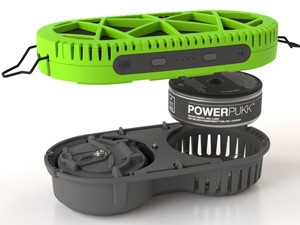
The MyFC PowerTrekk charger, based on micro fuel cell technology, developed at KTH Royal Institute of Technology in Stockholm, uses ordinary water to extend battery life for mobile devices by up to three watts.
The charger is both a fuel cell and a portable battery, providing a direct power source, as well as a storage buffer for the fuel. The PowerTrekk charger connects to the mobile device via USB.
KTH researcher and founder of MyFC, Anders Lundblad, says the device can be powered by fresh or seawater, and the water doesn't even have to be completely clean.
Lundblad says the PowerTrekk is a fuel cell-powered charger, fuelled with a puck. "When water is injected into the puck, hydrogen is generated and transferred to the fuel cell where the electrical current is supplied to the power electronics."
When plain water is poured onto a small recyclable metal disc inside the unit, hydrogen gas is released and combines with oxygen to convert chemical energy into electrical energy. This results in a charge that is enough to power an iPhone to between 25% and 100% of its battery capacity.
"The power electronics provides 5V (standard USB-A) and the solution is a hybrid with a battery. Thus, the charger can also be charged from the wall plug or a laptop," adds Lundblad.
Vision
Lundblad says the business vision behind MyFC is to commercialise fuel cell technology and contribute to the development of environmental technology.
"The launch of our charger is a strategic move to gain wide acceptance of fuel cells throughout society. Our chargers may be considered expensive now; but in the longer term, as they reach a mass market, they would go down in price."
He adds that the charger is also the first step toward building fuel cells in laptops.
Lundblad says the device is suited for people who spend a lot of time outdoors, or have limited or no access to the electricity grid.
$229 is almost an order of magnitude more expensive than Africa's most popular phone - the Samsung E250.
He believes the invention has the potential to accelerate social development in emerging markets. "There are large areas that lack electricity, while mobile phones fulfil more and more vital functions, such as access to weather information or electronic payment."
Wishful thinking
MyFC plans to open an online shop for its MyFC PowerTrekk product. The company has already sold the technology to users in China, Japan, the US and much of Europe.
Fuseware CEO Mike Wronski says while the device is fascinating, it's impractical. "In some African countries, you don't even have disposable water available to charge this thing, let alone electricity."
He adds that the biggest barrier to entry in emerging markets will be its price. "$229 is almost an order of magnitude more expensive than Africa's most popular phone - the Samsung E250."
Share